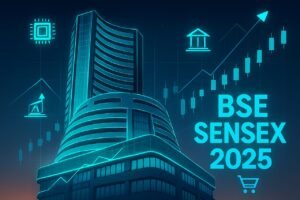BSE Sensex: What India’s Stock Market Barometer Tells Us in 2025
The BSE Sensex is more than just a stock market index—it’s a pulse check on India’s economic health and investor sentiment. In 2025, the BSE Sensex continues to be a crucial benchmark for tracking market movements, identifying trends, and guiding investors through India’s ever-evolving financial landscape. Whether you’re a beginner or a seasoned trader, understanding how the Sensex works is key to making smarter investment choices.

What Is BSE Sensex?
The BSE Sensex, or Bombay Stock Exchange Sensitive Index, is a benchmark index that tracks the performance of 30 well-established and financially sound companies listed on the Bombay Stock Exchange (BSE).
Key Characteristics of BSE Sensex:
-
Comprises 30 large-cap companies across sectors like finance, IT, energy, FMCG, and healthcare.
-
Market-capitalization weighted—larger companies have more influence on the index.
-
Represents India’s economic and market sentiment.
-
Used by investors and analysts globally to gauge the health of the Indian stock market.
The Sensex was launched in 1986 with a base value of 100, and today (as of July 2025), it’s hovering around 78,000 points, reflecting decades of economic growth and corporate success.
BSE Sensex vs Other Global and Indian Stock Market Indices
Understanding how the BSE Sensex stacks up against other Indian and global indices offers insight into its relevance.
| Index | Country | No. of Stocks | Type | Current Value (July 2025) |
|---|---|---|---|---|
| BSE Sensex | India | 30 | Large-cap | ~78,000 |
| Nifty 50 | India | 50 | Broad-based | ~23,400 |
| Dow Jones | USA | 30 | Blue-chip | ~40,300 |
| Nasdaq Composite | USA | 3000+ | Tech-heavy | ~17,200 |
| FTSE 100 | UK | 100 | Large-cap | ~8,300 |
Key Differences:
-
Nifty 50 includes a broader mix of companies, whereas Sensex is more focused and stable.
-
Global indices like Dow Jones and Nasdaq offer exposure to different sectors and economies.
-
Sensex remains a solid proxy for India-focused investors.
What’s Driving the BSE Sensex in 2025?
1. Economic Growth and Its Impact on the BSE Sensex
India’s GDP growth in FY2024-25 is estimated at 6.9%, led by strong domestic demand, infrastructure investments, and rising exports. This macro momentum is fueling optimism in equities, especially among foreign institutional investors (FIIs).
2. Banking and Financial Services Boom
Banks like HDFC Bank, ICICI Bank, and Kotak Mahindra Bank have posted record profits this year, contributing significantly to Sensex’s rally. The RBI’s continued support for liquidity and digital lending innovations is adding more fuel to the sector.

3. IT and Tech Comeback
Despite a global slowdown in 2023, IT majors like Infosys, TCS, and Wipro are regaining ground, thanks to a surge in AI, automation, and cloud service demand. These stocks form the backbone of tech representation in Sensex.
4. Manufacturing & Capex Push
With the government’s ‘Make in India 2.0’ initiative and PLI schemes in sectors like semiconductors and electric vehicles, industrial stocks like L&T and Reliance are seeing renewed investor interest.
5. Rising Retail Participation
India now has over 14 crore demat accounts, a 20% rise YoY, indicating a surge in retail investors who are directly influencing market volumes and sentiment.
Top Performing Sectors in the BSE Sensex This Year
Here’s a quick look at which sectors are leading the charge this year:
| Sector | Sensex Stocks Involved | YoY Growth |
|---|---|---|
| Banking & Finance | HDFC Bank, ICICI Bank, Kotak Bank | 28% |
| Information Technology | Infosys, TCS, Wipro | 22% |
| FMCG | Hindustan Unilever, ITC | 15% |
| Energy | Reliance Industries, Power Grid | 18% |
| Auto | Maruti Suzuki, M&M | 25% |
These numbers are based on combined stock performance and sectoral indices available from BSE India and NSE.
Sensex in Action: Real-Time Investor Takeaways
✅ Diversified Growth
Sensex includes companies across sectors, which helps balance out market volatility.
✅ Long-Term Returns
Historically, the BSE Sensex has delivered CAGR of 13–15% over 20 years—beating inflation and many traditional investment avenues.
✅ Global Trust
Being tracked globally through ETFs and derivatives, the Sensex enjoys international credibility and capital flow, especially from FIIs.
Should You Invest in Sensex-Linked Instruments?
Absolutely—if you’re looking for long-term, stable, and blue-chip exposure to India’s economy.
Investment Options:
-
Sensex Index Funds
-
Sensex ETFs (Exchange Traded Funds)
-
Direct Investment in Sensex Companies
Why Consider It?
-
Low-cost, passive investing
-
Diversified exposure in one fund
-
Ease of entry and exit through mutual funds or ETFs
📌 Tip: Choose an ETF with low tracking error and strong liquidity like HDFC Sensex ETF or ICICI Prudential Sensex Fund.
Common Mistakes to Avoid While Tracking the Sensex
-
Mistaking short-term volatility for trend reversal
-
Not understanding sector-specific risks (e.g., tech vs auto)
-
Overweighting Sensex-only strategies without mid/small-cap diversification
Expert Insights: What Analysts Say About Sensex in 2025
-
Morgan Stanley expects Sensex to hit 85,000 by early 2026, citing India’s growing role in global manufacturing.
-
Motilal Oswal projects strong earnings growth for Sensex companies, especially in banking and energy.
-
Jefferies India advises accumulating on dips, especially ahead of the 2026 general elections, as markets are likely to price in political stability.
A Personal Reflection: Watching the Sensex Over the Years
As an investor who started tracking Sensex in 2014—when it was hovering around 22,000—the journey to 78,000 has been nothing short of exhilarating.

I’ve seen market crashes, bull runs, reforms, and surprises—and one thing stands out: staying invested pays off. Through SIPs in Sensex-linked index funds, my portfolio has compounded steadily, teaching me that discipline > timing.
Conclusion: Sensex Is More Than a Number
The BSE Sensex is a reflection of India’s economic strength, corporate health, and investor optimism. In 2025, it’s not just about tracking numbers—it’s about understanding the story behind them. As India moves toward a $5 trillion economy, the Sensex will continue to be a key indicator of our progress.
📢 Call to Action
Are you tracking the BSE Sensex in your portfolio strategy?
💬 Share your experience or thoughts in the comments below!
👉 Explore our latest stock market guides or subscribe to our newsletter for expert investment tips every week.
